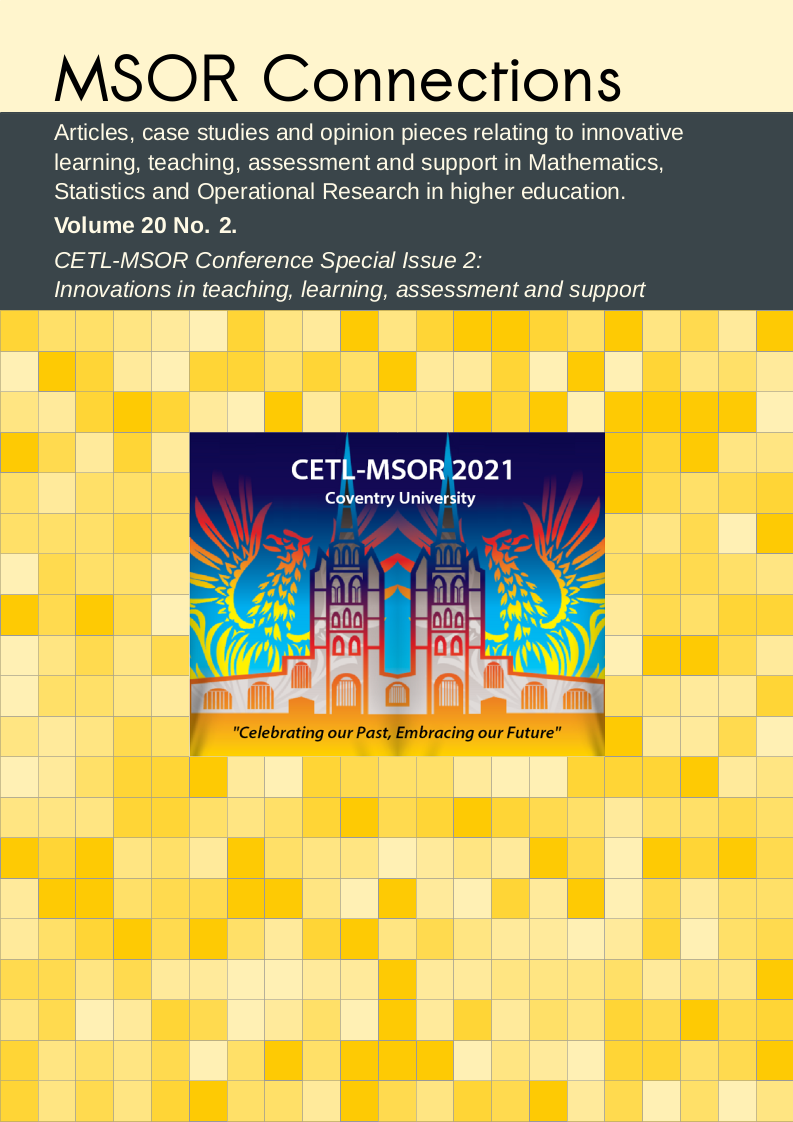Celebrating our past: once upon a time there was a cottage industry. Personal reflections on the development of mathematics support
DOI:
https://doi.org/10.21100/msor.v20i2.1305Keywords:
Mathematics SupportAbstract
Back in the early 1990's mathematics support was small-scale and loosely organised. Now, in 2021, it is to be found in the full range of university mission groups including those with the highest entry requirements. Today it is undoubtedly true that support centres are part of the landscape of higher education. They have evolved from offering local, drop-in support to first-year engineers to university-wide centres offering help to students in all disciplines and at all levels including postgraduates and sometimes staff. They contribute to university-wide priorities including recruitment, progression, retention, satisfaction, quality enhancement and employability. They have succeeded in raising issues such as the mathematics support of students with additional needs higher up institutional agendas and have firmly put the activities of those who work in this field on the radar of senior management of universities. This paper charts key milestones and events from the trajectory of mathematics support from 1990 to 2020 which have resulted in the thriving support services and community of practitioners that are evident today. It is based on a keynote presentation given by the author at CETL MSOR 2021.
References
ACME, 2011. Mathematical Needs: Mathematics in the workplace and in Higher Education. London: Royal Society. Available at: https://royalsociety.org/-/media/policy/Publications/2011/mathematical-needs-mathematics-in-the-workplace-and-in-higher-education-06-2017.pdf [Accessed 17 October 2021].
Beveridge, I., 1999. A tale of two surveys. Maths support Newsletter. 9, pp.20-23. Available at: http://www.sigma-network.ac.uk/maths-support-association-archive-1994-1999/ [Accessed 17 October 2021].
Biotechnology & Biological Sciences Research Council (BBSRC), 2010. The Age of Bioscience: Strategic Plan 2010-2015. Available at: https://vdocuments.net/bbsrc-strategic-plan-2010-2015-the-age-of-bioscience-driven-by-new-tools.html [Accessed 17 October 2021].
British Academy, 2012. Society Counts: Quantitative Skills in the Social Sciences and Humanities. Available at: https://www.thebritishacademy.ac.uk/publications/quantitative-skills-society-counts-social-sciences-humanities/ [Accessed 17 October 2021].
Clarke, C. , ed., 2014. The 'Too Difficult' Box: The Big Issues Politicians Can't Crack. London: Biteback Publishing.
Cockcroft Report, 1982. Mathematics Counts. London: HMSO. Available at: http://www.educationengland.org.uk/documents/cockcroft/cockcroft1982.html [Accessed 17 October 2021].
Hawkes, T. and Savage, M., 2000. Measuring the Mathematics Problem. London: Engineering Council. Available at: https://www.engc.org.uk/EngCDocuments/Internet/Website/Measuring%20the%20Mathematic%20Problems.pdf [Accessed 17 October 2021].
Lawson, D., 2003. Changes in student entry competencies 1991-2001, Teaching Mathematics and Its Applications, 22(4), pp.171-175. https://doi.org/10.1093/teamat/22.4.171
Lawson, D., 2004. Lessons from a decade of diagnostic testing. In: Hibberd, S. and Mustoe, L., eds. Mathematical Education of Engineers IV. Southend-on-Sea: Institute of Mathematics and Its Applications.
Marr, C, and Grove, M., eds., 2010. Responding to the Mathematics Problem: The Implementation of Institutional Support Mechanisms. Birmingham: Maths, Stats & OR Network. Available at http://www.mathcentre.ac.uk/resources/uploaded/mathssupportvolumefinal.pdf [Accessed 17 October 2021].
Smith, A., 2004. Making Mathematics Count. London: The Stationery Office. Available at: http://dera.ioe.ac.uk/id/eprint/4873 [Accessed 17 October 2021].
Willetts, D., 2013. Robbins Revisited: Bigger and Better Higher Education. London: Social Market Foundation.

